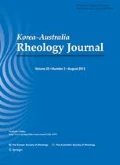Abstract
Isocyanate crosslinkers with blocking agents based on various amine derivatives were newly synthesized for automotive clearcoat applications. Amine-based blocking agents were prepared by varying the alkyl substituent attached on both sides of the main nitrogen atom (named DEA, DiPA, NtBEA, and NtBiA) to modify their deblocking feature in blocked isocyanates (BIs) and curing reaction under thermal curing conditions. Curing properties of clearcoats containing amine-based BIs were characterized at the normal curing temperature of 150°C and were compared with those by the commercialized BI, Desmodur® PL350. The dissociation ability of the amine-based BIs was interpreted using the density functional theory (DFT) simulation under their optimized geometric configurations. The urethane reaction between isocyanate group in BIs and hydroxyl group in a hydroxyl-functionalized polyol binder within clearcoats was confirmed from the OH stretching absorbance data via Fourier-transform infrared (FT-IR) spectrometer. The real-time cross-linking dynamics of various clearcoats with amine-based BIs were comprehensively investigated using rotational rheometer and rigid-body pendulum tester. The surface mechanical properties of fully-cured clearcoat films were measured by nano-indentation and nano-scratch testers to address the crosslinked network formation caused by amine-based BIs. It is demonstrated that the amine-based BIs could be favorably applied to thermal curing process of clearcoats, based on their reactivity and curing performance.
References
Adamsons, K., G. Blackman, B. Gregorovich, L. Lin, and R. Matheson, 1998, Oligomers in the evolution of automotive clearcoats: mechanical performance testing as a function of exposure, Prog. Org. Coat. 34, 64–74.
Bossion, A., G.O. Jones, D. Taton, D. Mecerreyes, J.L. Hedrick, Z.Y. Ong, Y.Y. Yang, and H. Sardon, 2017, Non-isocyanate polyurethane soft nanoparticles obtained by surfactant-assisted interfacial polymerization, Langmuir 33, 1959–1968.
Chiu, H.-T., and J.-O. Cheng, 2008, Thermal imidization behavior of aromatic polyimides by rigid-body pendulum rheometer, J. Appl. Polym. Sci. 108, 3973–3981.
Delebecq, E., J.P. Pascault, B. Boutevin, and F. Ganachaud, 2013, On the versatility of urethane/urea bonds: reversibility, blocked isocyanate, and non-isocyanate polyurethane, Chem. Rev. 113, 80–118.
Gregorovich, B.V., and I. Hazan, 1994, Environmental etch performance, and scratch and mar of automotive clearcoats, Prog. Org. Coat. 24, 131–146.
He, Z.A., and W.J. Blank, 1999, Crosslinking with malonate blocked isocyanates and with melamine resins, J. Coat. Technol. 71, 85–90.
Hwang, J.W., K.N. Kim, G.S. Lee, J.H. Nam, S.M. Noh, and H.W. Jung, 2013, Rheology and curing characteristics of dual-curable automotive clearcoats using thermal radical initiator derived from O-imino-isourea and photo-initiator, Prog. Org. Coat. 76, 1666–1673.
Jung, K.I., B. Kim, D.G. Lee, T.H. Lee, S.Y. Choi, J.C. Kim, S.M. Noh, Y.I. Park, and H.W. Jung, 2018, Characteristics of dual-curable blocked isocyanate with thermal radical initiator for low-temperature curing of automotive coatings, Prog. Org. Coat. 125, 160–166.
Lee, D.G., S. Sung, D.G. Oh, Y.I. Park, S.-H. Lee, J.C. Kim, S.M. Noh, and H.W. Jung, 2020, Application of polycarbonate diol containing hindered urea to polyurethane-based clearcoats for tuning of scratch-healing properties, J. Coat. Technol. Res. 17, 1–14.
Lee, K.C., S.B. Jeong, D.Y. Kim, T.H. Lee, S.C. Kim, J.C. Kim, S.-H. Lee, S.M. Noh, and Y.I. Park, 2018, Synthesis and radical polymerization properties of thermal radical initiators based on o-imino-isourea: The effect of the alkyl side chain on the radical initiation temperature, J. Polym. Sci. Pol. Chem. 56, 1749–1756.
Mühlebach, A., 1994, Pyrazoles-a novel class of blocking agents for isocyanates, J. Polym. Sci. Pol. Chem. 32, 753–765.
Noh, S.M., J.W. Lee, J.H. Nam, J.M. Park, and H.W. Jung, 2012a, Analysis of scratch characteristics of automotive clear-coats containing silane modified blocked isocyanates via car-wash and nano-scratch tests, Prog. Org. Coat. 74, 192–203.
Noh, S.M., J.W. Lee, J.H. Nam, K.H. Byun, J.M. Park, and H.W. Jung, 2012b, Dual-curing behavior and scratch characteristics of hydroxyl functionalized urethane methacrylate oligomer for automotive clearcoats, Prog. Org. Coat. 74, 257–269.
Oliver, W.C., and G.M. Pharr, 1992, An improved technique for determining hardness and elastic modulus using load and displacement sensing indentation experiments, J. Mater. Res. 7, 1564–1583.
Petit, H., N. Henry, A. Krebs, G. Uytterhoeven, and F. de Jong, 2001, Ambient cure high solids acrylic resins for automotive refinish clear coat applications, Prog. Org. Coat. 43, 41–49.
Ramezanzadeh, B., S. Moradian, A. Kohsravi, and N. Tahmassebi, 2012, Effect of polysiloxane additives on the scratch resistance of an acrylic melamine automotive clearcoat, J. Coat. Technol. Res. 9, 203–214.
Slinckx, M., N. Henry, A. Krebs, and G. Uytterhoeven, 2000, High-solids automotive coatings, Prog. Org. Coat. 38, 163–173.
Subramani, S., A. Sultan Nasar, T. Philip Gnanarajan, N. Padmanabha Iyer, and G. Radhakrishnan, 2000, Structure-property relationship of blocked diisocyanates: synthesis of polyimides using imidazole-blocked isocyanates, Polym. Int. 49, 546–550.
Tassel, X., D. Barbry, and L. Tighzert, 2000, A new blocking agent of isocyanates, Eur. Polym. J. 36, 1745–1751.
Wernståhl, K.M., and B. Carlsson, 1997, Durability assessment of automotive coatings-design and evaluation of accelerated tests, J. Coat. Technol. 69, 69–75.
Wicks, D.A., and Z.W. Wicks Jr., 1999, Blocked isocyanates III: Part A. Mechanisms and chemistry, Prog. Org. Coat. 36, 148–172.
Wicks, D.A., and Z.W. Wicks Jr., 2001, Blocked isocyanates III: Part B: Uses and applications of blocked isocyanates, Prog. Org. Coat. 41, 1–83.
Acknowledgements
This study was supported by the Ministry of Trade, Industry & Energy (MOTIE, Korea) under Industrial Technology Innovation Programs (No. 10067706 and No. 20004044).
Author information
Authors and Affiliations
Corresponding authors
Additional information
Publisher’s Note
Springer Nature remains neutral with regard to jurisdictional claims in published maps and institutional affiliations.
Rights and permissions
About this article
Cite this article
June, YG., Jung, K.I., Lee, T.H. et al. Effect of isocyanate crosslinkers blocked with amine derivatives on rheological and crosslinking characteristics of automotive clearcoats. Korea-Aust. Rheol. J. 33, 37–43 (2021). https://doi.org/10.1007/s13367-021-0004-2
Received:
Accepted:
Published:
Issue Date:
DOI: https://doi.org/10.1007/s13367-021-0004-2

